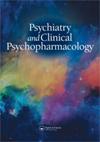Adjunct ketamine treatment effects on treatment-resistant depressive symptoms in chronic treatment-resistant schizophrenia patients are short-term and disassociated from regional homogeneity changes in key brain regions – a pilot study
IF 0.5
4区 医学
Q4 PHARMACOLOGY & PHARMACY
引用次数: 4
Abstract
ABSTRACT BACKGROUND: To investigate the effects of adjunct ketamine treatment on depressive symptoms and brain activity in chronic treatment-resistant schizophrenia (CTRS) patients with treatment-resistant depressive (TRD) symptoms. METHODS: Calgary Depression Scale for Schizophrenia (CDSS), positive and negative syndrome scale (PANSS), and regional homogeneity (ReHo) results were compared before versus after ketamine treatment in 12 CTRS patients with TRD symptoms. RESULTS: From 7 days to 14 days after the first ketamine administration, CDSS and PANSS total scores were reduced by 63.8% and 12.9%, respectively. By day 21, ReHo values had increased in the main components of the default mode network (DMN) and bilateral orbitofrontal cortex (OFC) after family-wise error correction. ReHo alterations did not correlate with TRD symptom changes. TRD symptoms relapsed by the 21-day time point, while increased ReHo was sustained. No adverse secondary effects (ASEs) necessitating medical intervention occurred. CONCLUSIONS: Adjunct ketamine alleviation of TRD symptoms lasted only a week, whereas increased ReHo in DMN regions and the OFC in CTRS patients was maintained beyond 2 weeks, indicating that adjunct ketamine is not well-suited for CTRS patients with TRD symptoms and that effects on functional activity dissociate from effects on TRD symptoms. This small-sample pilot study provides clues for further research into therapy for TRD symptoms in CTRS patients.辅助氯胺酮治疗对慢性难治性精神分裂症患者难治性抑郁症状的影响是短期的,并且与关键脑区的区域同质性变化无关——一项初步研究
摘要背景:探讨氯胺酮辅助治疗对慢性难治性精神分裂症(CTRS)伴难治性抑郁(TRD)患者抑郁症状及脑活动的影响。方法:比较12例伴有TRD症状的精神分裂症卡尔加里抑郁量表(CDSS)、阳性和阴性综合征量表(PANSS)以及区域均一性(ReHo)结果。结果:第一次给药后7 ~ 14 d, CDSS和PANSS总分分别下降63.8%和12.9%。到第21天,在家庭误差校正后,默认模式网络(DMN)和双侧眶额皮质(OFC)的主要成分的ReHo值增加。ReHo改变与TRD症状改变无关。TRD症状在21天时间点复发,而ReHo持续升高。没有发生需要医疗干预的不良继发性反应(ASEs)。结论:氯胺酮辅助治疗对TRD症状的缓解仅持续1周,而CTRS患者DMN区域ReHo升高和OFC维持超过2周,表明氯胺酮辅助治疗不适合TRD症状的CTRS患者,对功能活性的影响与对TRD症状的影响相分离。这项小样本的试点研究为进一步研究trs患者TRD症状的治疗提供了线索。
本文章由计算机程序翻译,如有差异,请以英文原文为准。
求助全文
约1分钟内获得全文
求助全文
来源期刊

Psychiatry and Clinical Psychopharmacology
Medicine-Psychiatry and Mental Health
CiteScore
1.00
自引率
14.30%
发文量
0
期刊介绍:
Psychiatry and Clinical Psychopharmacology aims to reach a national and international audience and will accept submissions from authors worldwide. It gives high priority to original studies of interest to clinicians and scientists in applied and basic neurosciences and related disciplines. Psychiatry and Clinical Psychopharmacology publishes high quality research targeted to specialists, residents and scientists in psychiatry, psychology, neurology, pharmacology, molecular biology, genetics, physiology, neurochemistry, and related sciences.
 求助内容:
求助内容: 应助结果提醒方式:
应助结果提醒方式:


